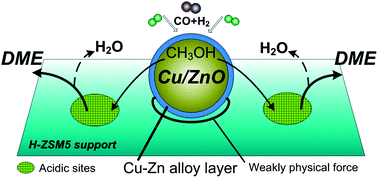Fabrication of active Cu–Zn nanoalloys on H-ZSM5 zeolite for enhanced dimethyl ether synthesis via syngas†
Abstract
One-step conversion of CO and H2 to dimethyl ether (DME) is still challenging to date. This work describes a promising bifunctional Cu/ZnO/H-ZSM5 catalyst prepared by a novel bimetallic sputtering method for such conversions. The sputtered catalyst consisted of well-dispersed Cu–ZnO nanoparticles of about 5 nm, which were physically anchored on an acidic zeolite support. The weak interaction between the deposited metal and zeolite clearly lowered the reduction temperature by 50 °C. After H2 reduction, a unique Cu–Zn nanoalloy layer was observed on the surface of the Cu–ZnO nanoparticles, reducing the activation energy of CO adsorption. The surface alloy layer and inner Cu–ZnO sites play a cooperative catalytic role in improving the CO conversion and promoting DME selectivity. Compared to conventional impregnated catalysts, the CO conversion was enhanced by almost four times and the DME selectivity was promoted to as high as 92.1%. The proposed concept is beneficial for developing highly-active catalysts with bimetallic components supported on a functional support.


 Please wait while we load your content...
Please wait while we load your content...